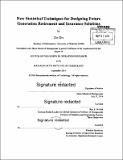| dc.contributor.advisor | Roy E. Welsch. | en_US |
| dc.contributor.author | Zhu, Zhe | en_US |
| dc.contributor.other | Massachusetts Institute of Technology. Operations Research Center. | en_US |
| dc.date.accessioned | 2015-01-05T20:07:13Z | |
| dc.date.available | 2015-01-05T20:07:13Z | |
| dc.date.copyright | 2014 | en_US |
| dc.date.issued | 2014 | en_US |
| dc.identifier.uri | http://hdl.handle.net/1721.1/92699 | |
| dc.description | Thesis: Ph. D., Massachusetts Institute of Technology, Sloan School of Management, Operations Research Center, 2014. | en_US |
| dc.description | Cataloged from PDF version of thesis. | en_US |
| dc.description | Includes bibliographical references (pages )103-106. | en_US |
| dc.description.abstract | This thesis presents new statistical techniques for designing future generation retirement and insurance solutions. It addresses two major challenges for retirement and insurance products: asset allocation and policyholder behavior. In the first part of the thesis, we focus on estimating the covariance matrix for multidimensional data, and it is used in the application of asset allocation. Classical sample mean and covariance estimates are very sensitive to outliers, and therefore their robust counterparts are considered to overcome the problem. We propose a new robust covariance estimator using the regular vine dependence structure and pairwise robust partial correlation estimators. The resulting robust covariance estimator delivers high performance for identifying outliers under the Barrow Wheel Benchmark for large high dimensional datasets. Finally, we demonstrate a financial application of active asset allocation using the proposed robust covariance estimator. In the second part of the thesis, we expand the regular vine robust estimation technique proposed in the first part, and provide a theory and algorithm for selecting the optimal vine structure. Only two special cases of the regular vine structure were discussed in the previous part, but there are many more different types of regular vines that are neither type. In many applications, restricting our selection to just those two special types is not appropriate, and therefore we propose a vine selection theory based on optimizing the entropy function, as well as an approximation heuristic using the maximum spanning tree to find an appropriate vine structure. Finally, we demonstrate the idea with two financial applications. In the third part of the thesis, we focus on the policyholder behavior modeling for insurance and retirement products. In particular, we choose the variable annuity product, which has many desirable features for retirement saving purposes, such as stock-linked growth potential and protection against losses in the investment. Policyholder behavior is one of the most important profit or loss factors for the variable annuity product, and insurance companies generally do not have sophisticated models at the current time. We discuss a few new approaches using modem statistical learning techniques to model policyholder withdrawal behavior, and the result is promising. | en_US |
| dc.description.statementofresponsibility | by Zhe Zhu. | en_US |
| dc.format.extent | 106 pages | en_US |
| dc.language.iso | eng | en_US |
| dc.publisher | Massachusetts Institute of Technology | en_US |
| dc.rights | M.I.T. theses are protected by copyright. They may be viewed from this source for any purpose, but reproduction or distribution in any format is prohibited without written permission. See provided URL for inquiries about permission. | en_US |
| dc.rights.uri | http://dspace.mit.edu/handle/1721.1/7582 | en_US |
| dc.subject | Operations Research Center. | en_US |
| dc.title | New statistical techniques for designing future generation retirement and insurance solutions | en_US |
| dc.type | Thesis | en_US |
| dc.description.degree | Ph. D. | en_US |
| dc.contributor.department | Massachusetts Institute of Technology. Operations Research Center | |
| dc.contributor.department | Sloan School of Management | |
| dc.identifier.oclc | 898332982 | en_US |
